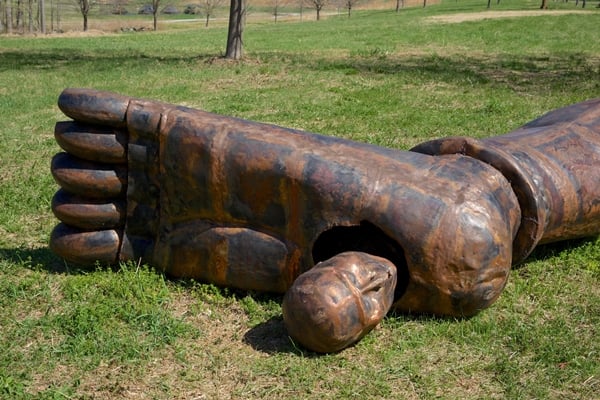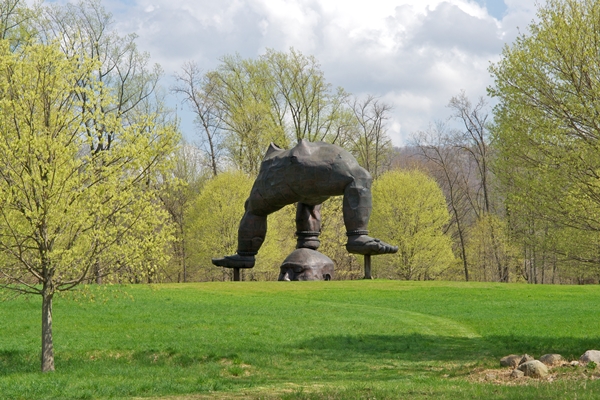It’s hard to believe that it was 20 years ago when Zhang Huan, then 29, first broke through to a certain kind of art-world fame and awareness of his work. At that point in his career, primarily a performance artist, he memorably protested living conditions in one slum, his own, by sitting in a public toilet motionless covered in honey and flies. Another piece highlighted the migrant worker population of his native China while others immersed the artist in escalatingly raw, dangerous, or bloody situations.
Less than a decade later, he was a star of the Whitney Biennial, naked save for a coat of beef, and releasing doves on Madison Avenue. A vibrant retrospective at the Asia Society followed in 2007.
Today his Three Legged Buddha, a deconstructed deity, sits at Storm King Art Center in Upstate New York, emblem of the exhibition of his work that opens there Saturday, May 3, and will run through Sunday, November 9.
“Zhang Huan: Evoking Tradition” includes more than 15 sculptures and works on paper by the artist. And what’s particularly striking about the show is that the six large-scale works exhibited outdoors seem to have always been meant for the hills they are placed upon. The resonant tone of a temple bell rings out over its 500 acres of land. A 2013 work Milly’s Temple opens a Ming Dynasty–era door widely into a field and has already attracted insects to its silver beehive. The Buddha (which has been on view at Storm King prior to the exhibition) alternatively pounces, dances, or presses defiantly into its grassy slope, depending upon which limb you are looking at. For art-worlders who believe they are already well-familiar with the Storm King space, the Zhang works change the energy significantly.
Touring the installation, the artist, soft-spoken, slight, and charismatic, talked again and again about the “strength” of the works and their peaceful intent. (His gray pants bag ever so slightly, as do his shoulders, when he speaks of the art, as the devout Buddhist seems to be trying to crumple himself politely rather than seem egotistical.) Zhang, speaking first through a translator, then less so, talked about why the Storm King property in Windsor, New York, is so important to him: “In 1998, he came to Storm King for the first time to see the energy and beautiful land and woods. He was completely taken.”
And: “Storm King is really a landscape [that is] very Western and all of their collection is mostly Western artists.” So it was part of a “process” that he, a Chinese artist, was invited, and an important one, the artist said. He had always wanted to show at Storm King since seeing it on an early visit to America years before, he said.
The installation is co-curated by Asia Society Museum director Melissa Chiu and David R. Collens, director of Storm King, along with the Center’s Nora Lawrence.

Zhang Huan, Head From Buddha Foot (2006), Copper
3′ 3″ x 18′ 8″ x 5′ 7″ (99.1 x 569 x 170.2 cm). Storm King Art Center
Photo: Courtesy Pace Gallery © Zhang Huan Studio.
Also at the Center, is a site-specific piece by Virginia Overton, a gleaming brass tube snaking 400 feet over a hay field. Arresting and interactive—visitors can speak or call into the hollow tube—it will be on exhibition through the seasons, and through Sunday, November 30. Overton’s road to Storm King could not have been more different than Zhang’s. An MFA student in Tennessee less than a decade ago, she had almost immediate success with graceful, elegant riffs on lumber and farm machinery, with works shown at Friedrich Petzel and Greene Naftali before landing at the swanky Mitchell-Innes & Nash.







